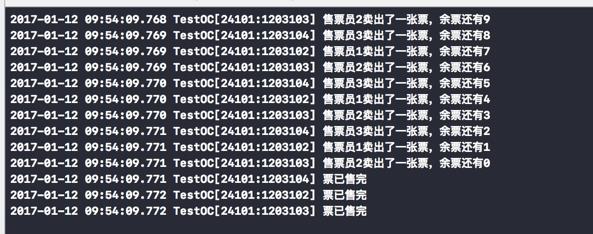iOS 多线程NSThread理解与场景示例
Posted 纠结的哈士奇
tags:
篇首语:本文由小常识网(cha138.com)小编为大家整理,主要介绍了iOS 多线程NSThread理解与场景示例相关的知识,希望对你有一定的参考价值。
NSThread是相对GCD和NSOperationQuene而言,比较轻量级的一种多线程处理方式。
但同时,它的弊端就是需要自己管理线程的生命周期,以及线程同步;而另外两种不需要自己管理。
常见方法介绍:
一、获取当前线程
NSThread *current = [NSThread currentThread];
二、获取主线程
NSThread *main = [NSThread mainThread];
三、NSThread的创建
1 // 初始化线程 2 NSThread *thread = [[NSThread alloc] initWithTarget:self selector:@selector(run:) object:@"aaa"]; 3 // 开启线程 4 [thread start];
.静态方法
+ (void)detachNewThreadSelector:(SEL)selector toTarget:(id)target withObject:(id)argument;
[NSThread detachNewThreadSelector:@selector(run:) toTarget:self withObject:@""];
执行完上面代码后会马上启动一条新线程,并且在这条线程上调用self的run方法。
.隐式创建线程
[self performSelectorInBackground:@selector(run:) withObject:@""];
会隐式地创建一条新线程,并且在这条线程上调用self的run方法。
四、暂停当前线程
[NSThread sleepForTimeInterval:2];
NSDate *date = [NSDate dateWithTimeInterval:2 sinceDate:[NSDate date]]; [NSThread sleepUntilDate:date];
上面两种做法都是暂停当前线程2秒
退出线程
[NSThread exit];
五、线程的其他操作
1.在指定线程上执行操作
1 [self performSelector:@selector(run) onThread:thread withObject:nil waitUntilDone:YES];
* 上面代码的意思是在thread这条线程上调用self的run方法
* 最后的YES代表:上面的代码会阻塞,等run方法在thread线程执行完毕后,上面的代码才会通过
2.在主线程上执行操作
[self performSelectorOnMainThread:@selector(run) withObject:nil waitUntilDone:YES];
在主线程调用self的run方法
3.在当前线程执行操作
[self performSelector:@selector(run) withObject:nil];
在当前线程调用self的run方法
场景1:
异步下载一张图片,下载完在UI显示。
代码实现:
//开启子线程下载
[NSThread detachNewThreadSelector:@selector(downloadPic) toTarget:self withObject:nil]; //下载图片 -(void)downloadPic{ NSURL *url = [NSURL URLWithString:@"https://res.wx.qq.com/mpres/htmledition/images/mp_qrcode218877.gif"]; NSData *pic = [NSData dataWithContentsOfURL:url]; UIImage *img = [UIImage imageWithData:pic]; //回到主线程显示 [self performSelectorOnMainThread:@selector(showImg:) withObject:img waitUntilDone:YES]; } -(void)showImg:(UIImage *)image{ //imageView.image = image NSLog(@"显示 pic"); }
六、多线程安全与加锁
说明:多线程访问同一个资源的时候可能会出现数据错乱等安全问题,解决方法是对必要的代码段进行加锁。
注意:在OC中加互斥锁使用@synchronized(self) {},在swift可以使用objc_sync_enter(self)和objc_sync_exit(self)方法,注意这两个方法必须成对使用,把要加锁的代码放在中间.
场景1:
以售票为例:3个售票员同时售票,票总数为10。
- (void)sailTicket { NSThread *thread1 = [[NSThread alloc] initWithTarget:self selector:@selector(sale) object:nil]; NSThread *thread2 = [[NSThread alloc] initWithTarget:self selector:@selector(sale) object:nil]; NSThread *thread3 = [[NSThread alloc] initWithTarget:self selector:@selector(sale) object:nil]; thread1.name = @"售票员1"; thread2.name = @"售票员2"; thread3.name = @"售票员3"; [thread1 start]; [thread2 start]; [thread3 start]; } -(void)sale{ while (1) { @synchronized (self) { for (int i = 0; i<10000; i++) { //模拟延迟 } if (_ticketCount>0){ _ticketCount--; NSLog(@"%@卖出了一张票,余票还有%lu",[NSThread currentThread].name,(unsigned long)_ticketCount); }else{ NSLog(@"票已售完"); break; } } } }

可以很明显看出,每个售票员都是严格按照从10递减的方式售票,不存在票数忽多忽少的情况。
如果不加锁:

以上是关于iOS 多线程NSThread理解与场景示例的主要内容,如果未能解决你的问题,请参考以下文章